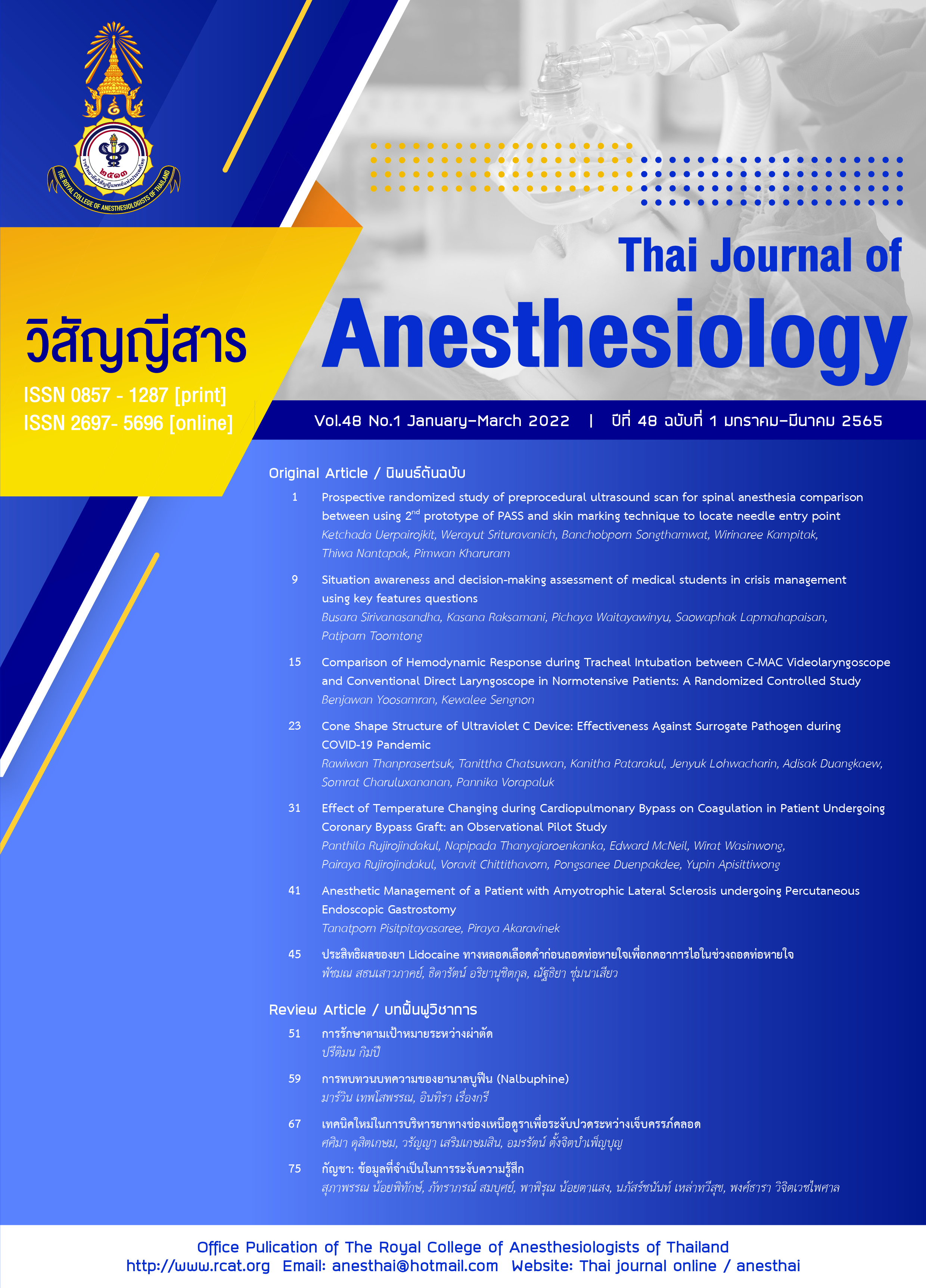Effect of Temperature Changing during Cardiopulmonary Bypass on Coagulation in Patient Undergoing Coronary Bypass Graft: an Observational Pilot Study
Main Article Content
Abstract
Background: Hypothermia and cardiopulmonary bypass (CPB) are the main factors that disturbed the coagulation process during cardiac surgery. Rotational thromboelastometry (ROTEM) can be used to monitor the coagulation changing from moderate hypothermia during coronary artery bypass graft (CABG) surgery. Objective: The purpose of this study was to assess the effect of induced hypothermia on standard coagulation test and ROTEM to detect hemostasis changes in elective CABG. Method: An observational pilot study was conducted on five patients. Blood samples were collected from the arterial line at six different time points: at baseline (after arterial cannulation), 5 minutes after heparinization, 10 minutes after CPB, when the rectal temperature reaching 32ºC, and 10 minutes after protamine administration. The patient’s serum was analyzed in ROTEM including INTEM, EXTEM, HEPTEM, FIBTEM, and standard coagulation test. Results: Our data showed prolongation of the coagulation time, clot formation time, and attenuation in alpha angle, A10 and maximum clot firmness (MCF) by INTEM, EXTEM, HEPTEM, and FIBTEM from ROTEM during hypothermia during cardiopulmonary bypass. The standard coagulation test showed a decrease in platelet counts. However, the decrease of platelet counts did not lead to a decrease in the hemostatic function of platelets, as assessed by MCF. Conclusion: No statistically significant differences between ROTEM and standard coagulation test from the effect of temperature change to moderate hypothermia (at 32ºC) during CPB in CABG surgical patient.
Article Details

This work is licensed under a Creative Commons Attribution-NonCommercial-NoDerivatives 4.0 International License.
References
Gronchi F, Perret A, Ferrari E, Marcucci CM, Fleche J, Crosset M, et al. Validation of rotational thromboelastometry during cardiopulmonary bypass: A prospective, observational in-vivo study. Eur J Anaesthesiol. 2014;31(2):68-75.
Despotis G, Eby C, Lublin DM. A review of transfusion risks and optimal management of perioperative bleeding with cardiac surgery. Transfusion. 2008;48(1 Suppl):2S-30S.
Johansson PI, Solbeck S, Genet G, Stensballe J, Ostrowski SR. Coagulopathy and hemostatic monitoring in cardiac surgery: an update. Scand Cardiovasc J. 2012;46(4):194-202.
Yau TM, Carson S, Weisel RD, Ivanov J, Sun Z, Yu R, et al. The effect of warm heart surgery on postoperative bleeding. J Thorac Cardiovasc Surg. 1992;103(6):1155-62; discussion 62-3.
Boldt J, Knothe C, Zickmann B, Bill S, Dapper F, Hempelmann G. Platelet function in cardiac surgery: influence of temperature and aprotinin. Ann Thorac Surg. 1993;55(3):652-8.
Tonz M, Mihaljevic T, von Segesser LK, Schmid ER, Joller-Jemelka HI, Pei P, et al. Normothermia versus hypothermia during cardiopulmonary bypass: a randomized, controlled trial. Ann Thorac Surg. 1995;59(1):137-43.
Haas T, Spielmann N, Mauch J, Madjdpour C, Speer O, Schmugge M, et al. Comparison of thromboelastometry (ROTEM(R)) with standard plasmatic coagulation testing in paediatric surgery. Br J Anaesth. 2012;108(1):36-41.
Weber CF, Klages M, Zacharowski K. Perioperative coagulation management during cardiac surgery. Curr Opin Anaesthesiol. 2013;26(1):60-4.
Levy JH, Dutton RP, Hemphill JC 3rd, Shander A, Cooper D, Paidas MJ, et al. Multidisciplinary approach to the challenge of hemostasis. Anesth Analg. 2010;110(2):354-64.
Ebinger T, Ruland A, Lakner M, Schwaiger M. Validity, regulatory registration and approval of ROTEM thromboelastometry. Blood Coagul Fibrinolysis. 2010;21(1):106-7.
Lee GC, Kicza AM, Liu KY, Nyman CB, Kaufman RM, Body SC. Does rotational thromboelastometry (ROTEM) improve prediction of bleeding after cardiac surgery? Anesth Analg. 2012;115(3):499-506.
Lang T, von Depka M. Possibilities and limitations of thrombelastometry/-graphy. Hamostaseologie. 2006;26(3Suppl1):S20-9.
Kettner SC, Sitzwohl C, Zimpfer M, Kozek SA, Holzer A, Spiss CK, et al. The effect of graded hypothermia (36 degrees C-32 degrees C) on hemostasis in anesthetized patients without surgical trauma. Anesth Analg. 2003;96(6):1772-6, table of contents.
Ogawa S, Szlam F, Chen EP, Nishimura T, Kim H, Roback JD, et al. A comparative evaluation of rotation thromboelastometry and standard coagulation tests in hemodilution-induced coagulation changes after cardiac surgery. Transfusion. 2012;52(1):14-22.
Finley A, Heinke T, Abernathy JH, 3rd, Guldan GJ, 3rd, Nelson E, Grogan K. An Abnormal EXTEM in the setting of a high heparin concentration. J Cardiothorac Vasc Anesth. 2015;29(4):1021-4.
Ji SM, Kim SH, Nam JS, Yun HJ, Choi JH, Lee EH, et al. Predictive value of rotational thromboelastometry during cardiopulmonary bypass for thrombocytopenia and hypofibrinogenemia after weaning of cardiopulmonary bypass. Korean J Anesthesiol. 2015;68(3):241-8.
Society of Thoracic Surgeons Blood Conservation Guideline Task F, Ferraris VA, Brown JR, Despotis GJ, Hammon JW, Reece TB, et al. 2011 update to the Society of Thoracic Surgeons and the Society of Cardiovascular Anesthesiologists blood conservation clinical practice guidelines. Ann Thorac Surg. 2011;91(3):944-82.


